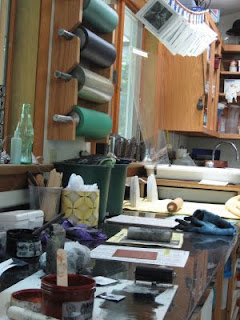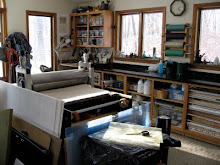 A local gallery holds a holiday exhibition every year called 6 by 6. For a reasonable entrance fee and a 20% commission, artists are invited to submit works that meet the 6" square requirement. The goal is to raise money for the gallery by providing the community with an opportunity to purchase original works of art. Out of curiosity, I decided to participate this year and submitted a few pieces. Because of the economy, I wasn't sure if the work would sell but was pleased to find that a couple of pieces had been purchased. Granted, they were priced at only $35 each but there was something about selling small works locally that appealed to me.
A local gallery holds a holiday exhibition every year called 6 by 6. For a reasonable entrance fee and a 20% commission, artists are invited to submit works that meet the 6" square requirement. The goal is to raise money for the gallery by providing the community with an opportunity to purchase original works of art. Out of curiosity, I decided to participate this year and submitted a few pieces. Because of the economy, I wasn't sure if the work would sell but was pleased to find that a couple of pieces had been purchased. Granted, they were priced at only $35 each but there was something about selling small works locally that appealed to me.Thursday, December 17, 2009
Gallery Holiday Show
 A local gallery holds a holiday exhibition every year called 6 by 6. For a reasonable entrance fee and a 20% commission, artists are invited to submit works that meet the 6" square requirement. The goal is to raise money for the gallery by providing the community with an opportunity to purchase original works of art. Out of curiosity, I decided to participate this year and submitted a few pieces. Because of the economy, I wasn't sure if the work would sell but was pleased to find that a couple of pieces had been purchased. Granted, they were priced at only $35 each but there was something about selling small works locally that appealed to me.
A local gallery holds a holiday exhibition every year called 6 by 6. For a reasonable entrance fee and a 20% commission, artists are invited to submit works that meet the 6" square requirement. The goal is to raise money for the gallery by providing the community with an opportunity to purchase original works of art. Out of curiosity, I decided to participate this year and submitted a few pieces. Because of the economy, I wasn't sure if the work would sell but was pleased to find that a couple of pieces had been purchased. Granted, they were priced at only $35 each but there was something about selling small works locally that appealed to me.Versacel Plates
 This Versacel print was created in two sections. A rectangle was cut from the main plate and the fish image was drawn using a standard etching needle. The rest of the plate was created by embossing netting and using a metal stamp tool to create patterns and textures. It was inked in two separate sections - the fish inked and wiped as an intaglio and the main plate inked as a relief - then reassembled as one plate and run through the press.
This Versacel print was created in two sections. A rectangle was cut from the main plate and the fish image was drawn using a standard etching needle. The rest of the plate was created by embossing netting and using a metal stamp tool to create patterns and textures. It was inked in two separate sections - the fish inked and wiped as an intaglio and the main plate inked as a relief - then reassembled as one plate and run through the press.
This image shows how delicate lines can be scribed into Versacel to create detailed drawings. The scissors were embossed into the plate and small marks were cut into the plate using linoleum cutting tools. It's a two section plate that was inked, wiped and printed as an intaglio.
Versacel is an interesting material to work with and provides endless opportunities for printmaking experimentation. (I've even applied ImagOn photopolymer film to it. Its make up allows the plate to sit in the soda ash bath with no ill effects.) It's fairly inexpensive, easy to cut, and holds up to the rigors of printmaking; definitely worth playing around with.
Background Plate
 Now that I'm happy with the intaglio plates, I've turned my attentions to the larger base plate that I will use in conjunction with the two smaller copper plates.
Now that I'm happy with the intaglio plates, I've turned my attentions to the larger base plate that I will use in conjunction with the two smaller copper plates.A few years ago I came across a material called Versacel. I believe it's used in the sign business and reminds me of a dense form of styrafoam. It makes a great surface to print from because it is very rigid, can be easily incised with carving tools, drawn into with a ball point pen or sharp pointed tool, materials can be glued to its surface for collagraphic techniques, and objects can be embossed into it. The girdle pictured above was embossed onto the Versacel by running it through the press to pick up some of the details of the garment.
 My intentions are to add various materials and textures to build up the surface as a collagraph. I plan to ink this as an intaglio with a surface relief roll and then place the copper plates on top to run the whole thing through the press as one. We'll see how this develops.
My intentions are to add various materials and textures to build up the surface as a collagraph. I plan to ink this as an intaglio with a surface relief roll and then place the copper plates on top to run the whole thing through the press as one. We'll see how this develops.I purchase my Versacel from Industrial Safety Supply Co.,176 Newington Road, West Hartford, CT 06133-0720 Phone: 860-233-9881. It comes in 4' X 8' sheets but they cut it down to more manageable sizes to ship.
Prior Proper Planning Prevents .....

When working with photopolymer processes it's extremely important to do test plates to get the light exposure correct for the particular image you're working with. You need to adjust for the density of your negative, the materials used to create it, your particular light source, use of an aquatint screen and the type of photopolymer film or plate. Too much exposure and you burn out the detail in your image and get a very light print. Too little exposure and you don't get enough detail.
Now, I will be the first to admit that patience is not one of my strong points and I love to just jump right in and see what happens. This often works because of my past experience but there are times when an image just wont print as intended and there is no other alternative than to step back and do some exposure tests.

I adhered one layer of ImagOn to a copper plate and exposed it to an aquatint screen. The screen I favor is produced by Elizabeth Dove http://www.elizabethdove.com/screens/index.html. (I met Elizabeth in 1995 when we were attending one of Keith Howard's Masters Workshops in Peace River, Alberta. She went on to do a lot of research with the photopolymer film and is featured in Howard's books.)
I "step" exposed the aquatint screen to light units in increments of 10. After removing the aquatint screen, I placed the image negative over the plate and exposed that to varying amounts of light. This test plate was developed and printed and I was able to determine which exposure, for both the aquatint screen and the negative, worked best for this particular image. I made a new set of plates using the appropriate exposure times and was happy with the results. Now, if I would just do this with each new image I would save myself a lot of time and frustration.
Enjoying the Season

The end of the year and the holiday season is such a busy time with all the decorating, shopping, baking, and entertaining. It's difficult to follow through on studio projects and it's frustrating for me to lose momentum when I have a piece in the works. This is when I need to remind myself to relax and go with the flow and just take time to enjoy the season and time with family and friends. I know I'll be able to pick up where I left off once things get back to normal.
To get in the holiday mood, I decided to gift my friends with an original print so I spent a couple of days editioning and putting together cards. (It was actually a lot of fun.) The relief print is based on a photo I took of our garden bench when it was covered in snow earlier this month. I was drawn to the serenity of the scene and felt that it really represented the peace we all seek.
May you all enjoy the best the season has to offer!
Thursday, November 19, 2009
Plexiglass Plates

These are the plates for the "girdle" images. They're a little difficult to see but are Plexiglass bases covered with ImagOn. We'll see what happens when they're proofed. I'm a little worried that they may print too dark.
Now that I've caught up on my blogging, it's back to the drawing board (or the printing press in this case).
Using Photos

I'm always trying to get to something--an image, a color, a feeling--that seems honest and real to me. My work often begins with my own photographic images, but that's just the beginning. I put the images through various processes, working to transform them into something more emotionally expressive. Transformations come about in several different ways: sometimes they're created through deliberate action, sometimes through the very nature of a particular printing process, and sometimes through pure accident. What is consistent is that I'm always looking for that point when what is photographically real remains in the image but finds a new life, vitality and a new reality through the lines, colors, gestures, scrapes, and textures that are layered over that memory. What matters to me in the print, is what that subject matter is trying to express.
This is another multiple plate image; two photopolymer plates and one collagraph strip with lace.Shown here are the negatives I've made and the lace plate below.
I began by photographing myself in an old corset. Images were loaded into PhotoShop and altered. I then "collaged" images to create the second negative. Right now my intentions are to print the plates but leave the lace as an embossing. We'll see how the proofing goes.
Making Plates

The large plates have a Plexiglass base with ImagOn adhered to the surface. After seeing the proofs, I've decided to add a couple of additional layers of ImagOn to the top and bottom portions of the right hand plate. ImagOn works really well if you are someone who enjoys layering and building up images. The best part is, if you find the plate isn't working out, the film can easily be stripped off so you can reclaim the basic plate.

For the small plates, I'm using roofing copper. The square plate was easily cut to size on my old paper cutter. I wanted an oval shape for one image and had to figure out the best way to get the most accuracy when cutting the plate. My first thought was to grab my jewelers saw and blades and carefully cut out the shape. After some experimenting on scraps, I found that I could quickly and accurately cut the shape using my metal cutters. Next step is to apply the ImagOn.
Maze Image

I've been playing around with incorporating mazes in my works to symbolize the often convoluted paths we take to reach our destinations. This piece has been in my sketches for awhile, just pulling at the edges of my mind, so I needed to get it out; soon.
I began by designing a large rectangular maze. Once I had the design in place, I laid a sheet of Mylar over the sketch and then used strips of solid black tape to lay out the image. This in essence created a large transparency that I could use to expose a plate.
My intentions are to use four or five plates to create this piece. Two large background images, one large wood block to create texture and color behind the maze plate and then two smaller plates. With the exception of the wood block, the plates will be phoyopolymer intaglios.
I'm now at the point where I'm contemplating the background proofs, deciding where I need to make adjustments, and whether or not to incorporate chine colle for the smaller plates. Lots of decisions at this point and since there are so many "pieces", all I can do is spend a few days experimenting with my options.
In The Works

I've been playing around with a couple of ideas and working out sketches for the past few days that deal with images and themes that crop up in my work. As I work, my goal is to keep alive spontaneity and the original intuitive impulse as I search for elegant solutions to creative challenges. Because I enjoy layering and piecing together plates, there are times when I'm never really sure if the piece will succeed or if it will have to be scrapped completely. If I'm successful, hopefully, the unexpected results will speak of dimensions beyond my original intent and lead to revelations about feelings and ideas.
Tuesday, November 17, 2009
Relaxing Evening
Got up early this morning and was at work in the studio by seven a.m. Managed to get two plates ready for proofing, paper cut to size and a few works prepped for a show. The best way to end a satisfying day is to sit out in the yard and watch the crows put on their daily show as the sun sets. Then sitting by the fire with some excellent sipping rum puts the finishing touch on a perfect day.
Six for NAC Gallery
Holiday Sales
This is the time of year that a lot of galleries hold holiday sales and my local gallery is no exception. The only criteria is that all work must be no larger than 6" X 6" and ready to hang. The gallery's goal is to encourage folks to consider original works of art and crafts when doing their holiday shopping. I decided to give it a try and spent the morning rounding up a few pieces that fit the guidelines.
After breaking out my shrink wrapping supplies I needed to come up with a way to make the pieces "ready to hang". Good old duct tape and a hole punch did the trick. Add a little wire and the job was complete.
Tuesday, November 10, 2009
Decisions, Decisions, Decisions
After refining sketches and creating a number of plates, I've been proofing and trying out various configurations and color options. I reworked a few of the plates because they just wouldn't print as I had intended and I wasn't happy with the images. I'm happy with some of the new individual plates but not yet satisfied with how they relate to each other. When it seems as though I'm just "running on ice" I find it best to clean up and pack it in for the day. I'll start fresh in the morning and hopefully things will start to come together.
Wednesday, November 4, 2009
Recalibration
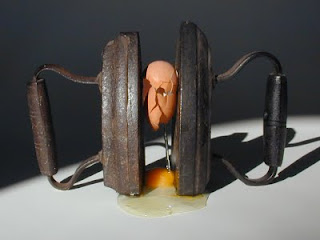
"In art intentions are not sufficient ... What one does is what counts and not what one has intentions of doing." Picasso
I am reminded of this quote whenever I get to that point where I have too many projects and/or ideas "in the works" and I find myself flitting from one to another but never following through on any one in particular. It's paralyzing and something that I find happening more, now that I'm retired. When I was working and had a hundred and one things to accomplish in a set period of time, I didn't have the luxury to second guess everything. It was get it done and move on or there would be consequences. I took pride in the fact that I always managed to be creatively productive, throughout my career, and made it a point to participate in exhibitions on a regular basis. (I sometimes wonder how in the world did I manage the responsibilities of being an artist, wife, homemaker, mother, and teacher!) What can I say other than I'm the quintessential type A personality!
When I was young, a high school art teacher admonished me for always having "too many irons in the fire". As I look back on my life, I have to chuckle because that has stuck with me and was such an accurate assessment. But then again, I need to ask - Is that such a bad thing? I think that I just need to recalibrate my way of thinking and be more realistic in my expectations. Maybe it's just taking me longer than I realize to shed that sense of constantly needing to meet demands on a set schedule. (I can be my own worst enemy at times!) I need to remind myself to relax and go with the flow; enjoy this new stage of life and focus more on the pure joy of the creative process rather than feeling the need to constantly produce. If I can accomplish this I know I'll be less "hardpressed".
Wednesday, October 28, 2009
Sketches & Plate Making
After playing around with some sketches and ideas, I began experimenting with my reduced body prints using PhotoShop, to manipulate the images. I settled on a few of my favorites and printed them out on transparencies.
Once I sorted through my photopolymer supplies, yesterday was spent creating plates. I decided to go with Solarplates, for my relief plates and those involving text, and use ImagOn film for the intaglio components. In this instance, I adhered the film to sheets of plexiglass. I also use roofing copper and galvanized metal as plates.
It's exciting to be able to take a large body print and reduce it down to a more intimate format. I'll have fun seeing where this takes me.
Early Body Prints
 This "Mother/Daughter Power Struggle" was printed using acrylic gesso and then color was added using oil paint and pastels. (And yes, I successfully talked my daughter into being inked.)
This "Mother/Daughter Power Struggle" was printed using acrylic gesso and then color was added using oil paint and pastels. (And yes, I successfully talked my daughter into being inked.) This is a print collage that includes molded hand-made paper dolls, a transfer rubbing, a body print and assorted collage material.
This is a print collage that includes molded hand-made paper dolls, a transfer rubbing, a body print and assorted collage material.
Revisiting an Idea

Years ago, I did a series of large monoprints using my body as the matrix. This involved inking myself up and then pressing against a sheet of paper. As you can imagine, it gets a little messy but the results can be fantastic. (I even talked my husband into lending me his body for this project...love is a wonderful thing!)
I found this old Polaroid snapshot (cropped for modesty) and couldn't stop laughing ... or remembering how much fun I had rolling in the ink. When I was covered in ink, it almost felt as though I was wearing clothes!
I experimented with water-based inks and acrylic gesso. I would first rub on some body lotion to help with clean up and then apply the printing medium; either directly with a roller or by laying on a surface that I had inked up. Then I would simply press against paper that was either pinned to the wall or laid out on the floor. The black & white prints were left as is or used in print collages and the gesso prints were colored using oil paints and/or pastels.
I decided to revisit this approach but on a smaller scale. Obviously the monoprints were life sized but I wanted to create smaller intaglio works based on this idea. I did some new body prints and photographed the results which allowed me to reduce them in size. (Now, if only it was this easy to "reduce" the actual matrix!!
Non-Toxic "Bibles"
 I consider these publications indispensable for the printmaker who is interested in non-toxic processes. They walk you through all of the steps needed to create successful plates using photopolymer techniques. When I bought a copy of Keith Howard's "Non-Toxic Intaglio Printmaking" I was delightfully surprised to find that one of my prints had been used in the book!
I consider these publications indispensable for the printmaker who is interested in non-toxic processes. They walk you through all of the steps needed to create successful plates using photopolymer techniques. When I bought a copy of Keith Howard's "Non-Toxic Intaglio Printmaking" I was delightfully surprised to find that one of my prints had been used in the book!You can also find quite a bit of info on line. A good place to start is http://www.nontoxicprint.com/
Film, Film Everewhere!
Digging through my supplies yesterday I discovered that I have 4 different types of photopolymer film tucked away in the studio. I have a little left of the original Riston made by Dupont and used in the circuit board industry (that I carted back from Peace River, Alberta, Canada back in 1995), then I have ImagOn (the follow up to Riston and marketed for non-toxic printmaking), I just finished up my supply of "the new and improved" ImagOn Ultra and I found a brand new roll of ImagOn Pro. Although I don't currently have any on hand, I understand there is now an ImagOn HD (guaranteed to provide better resolution).
It's interesting to see how the film has changed over the years. Along with a great variety of image making possibilities, the film has gone through several stages since I first used the Riston back in '95. Adhering procedures and development processes have changed, resolution has improved and the films have gone from thick to thin and back to thick again with the ImagOn Pro. I just need to keep track of which film I'm using so I follow the adhering & processing recommendations for that particular film. It's also interesting to note that if they're stored properly they have a decent shelf life. I don't store my film on end, keep it in it's original tube and well wrapped in light proof plastic and make sure it's kept in a cool location. I made a special light proof black box for a larger roll of film that makes access to the roll quick and easy.
What I really appreciate about all of the developments in non-toxic printmaking is that this new technology allows me fantastic image-making capabilities without compromising my health, safety or the environment.
Monday, October 19, 2009
Print Zero Exchange

Just received my portfolio of prints from the Print Zero Exchange 6 and was pleased to find some interesting little prints. The level of craftsmanship in this group was much better than in previous exchange portfolios. I was also delighted to find that one of the works was that of a former student...small world!
Thursday, October 15, 2009
New Beginnings
Recently, I've had a difficult time focusing on my work because I've been traveling back and forth between two locals. Now that summer is officially over, it's time to settle down and put in some quality studio time.
I have always looked at autumn as a time for new beginnings. I guess when one's a teacher this is an occupational proclivity; new academic year, new students, new beginnings and fresh challenges. Even though I have been retired for 2 years, I still get that familiar stirring in my bones to gear up and start anew. I've been working on several sketches for new prints and can feel that old familiar yearning for new challenges. I wonder where the path will lead?
Keeping in Touch
An occasional visit is good for the soul and I think I'll make more of an effort to take the time to get out an about. Next time, my studio.
Friday, October 2, 2009
New Exchange Prints
I just received my set of prints from the 2009 Green Door International Print Exchange. It was their first exchange and they did a great job getting the prints back out to the participants, as advertised.
It's always interesting so see what you'll end up with when participating in an exchange. My goal was to try out a few this year and over all, the experience has been positive and a good tool to keep you working.
Sunday, August 23, 2009
Body Print
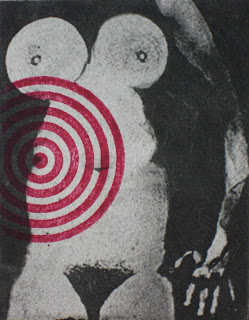
For the Green Door Exchange I created a small print based on a "body print". I used my own body as a matrix to create a one of a kind monotype. I began by inking my body with waterbased ink. Once I was sufficiently covered in ink, I pressed myself against a sheet of paper that I had laid out on the floor of my studio. This monotype was photographed and resized in Photoshop to meet the guidelines for the exchange. (The maximum paper size had to be 5.5"X5.5".) I then created a negative, exposed it to a photopolymer plate and inked and wiped the plate as an intaglio. A second plate was inked and printed as a relief over the first image to complete the print.
This was an interesting process and I already have plans to create a few more prints using this technique.
Final Exchange Project
The exchanges I participated in were interesting. The deadlines were a great tool for keeping me focused and on task and they also required discipline to complete professional looking editions. On the negative side, I was often disappointed by the quality of the prints I received in return and have come to realize that this is more often the norm for exchanges. One never knows what you will get in return because the exchanges are open to professional as well as non-professional print makers. I eventually learned not to take the whole process too seriously and to just have fun with the guidelines presented for each exchange.
I'm still waiting to receive my exchange prints from Print Zero, Art House and the Littlest Print Exchanges and will post the prints I receive as they arrive.
Monday, August 3, 2009
To Hand Color or Not?
Drying Prints
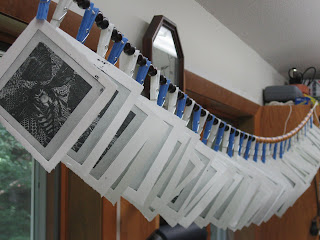
Knowing that I was going to print 50 images, I decided that I needed an efficient drying system other than laying wet prints around the studio. Years ago I had made a drying "rack" from clothes pins and decided to redo that symple system. Over the weekend I gathered my supplies and easily threaded strong cord through clothes pins that conviently came with perfectly placed holes. I used some wooden beads as separators between the pins. I can easily move this drying system around to accomodate my needs.
Paper Soaking & Blotting

I like using Akua waterbase ink and one of my favorite papers is Hahnemuhle-Copperplate, which doesn't need to be soaked too long.
Here's my set up for paper preparation. I angle a sheet of plexiglass over a basic water soaking tray. Next to the tray I place a super absorbent, lint free towel. I remove the paper from the tray, place it against the plexiglass and use a window squeegee to remove excess water. I then lay the paper on the absorbent towel, cover it with another towel and roll the surface. This gives me perfectly dampened paper and eliminates the need for paper blotters. This works very well and the towels can be easily cleaned, washed and reused.
I have a collection of antique irons which come in very handy in the studio. Here I'm using them to hold the towel in place AND hold the rolling pin. They also come in handy as weights, to hold down paper when positioning multiple plates.
"Littlest Print" Exchange
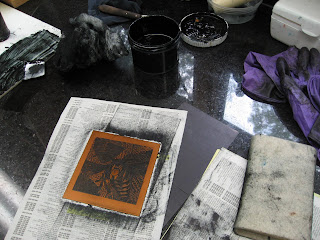
Latest exchange project in the works. An edition of 50 due by September first means that I need to settle on an idea and follow through. The maximum paper size is 3.5" X 3.5" so I'm letting the image bleed off the edges.
I used Photoshop to create an image based on scanned sketches and photographs. The Solarplate was first exposed to an aquatint screen and then the transparency. Here it is inked up. I use a felt wrapped block wrapped in phone book pages to wipe the plate. There is a piece of magnetic material taped to my work surface which holds the plate down. I find this really helpful, especially when the plate is so small.
Planning & Proofing

When I begin a piece I never know where it's heading and often it becomes something quite different than originally intended. I know that in my work the best pieces are the ones that just happen - ideas that were suddenly caught and that I hadn't anticipated. Sometimes when I play around with various images and sketches I reach a point where I begin to over work things and end up not pleased with the results. Also, if I keep playing around with an image I lose the freshness that I'm searching for; when this happens I find that I'm better off just putting the idea on the back burner for awhile.
Tuesday, July 21, 2009
Exposed Plate

Here's the finished plate. This one has two layers of Imagon film; layer #1 a dot screen exposure and layer #2 the image. I could proof the plate now but it's getting late and I'd be better off starting fresh in the morning.
There are good step by step instructions for using Imagon film in Keith Howard's books. Book one is titled Non-Toxic Intaglio Printmaking (one of my prints is on page 26) and his second book is The Contemporary Printmaker.
It's important to remember that you need access to a good exposure unit with a vacuum frame. Look on line and you may get lucky like I did and find one with plenty of life left in it. Also, most classrooms and print studios usually have one these days since there's been an emphasis on less toxic printmaking processes.
Final Steps


When the plate has developed for 9 minutes, remove it from the soda ash bath and rinse it under running water for a minute and GENTLY wipe it with a SOFT sponge. Spritz the plate with white vinegar to stabilize it. Finish up by blotting it with newsprint and dry with heat gun. Your plate is now ready to print.
Image Exposure

Once you peel off the protective layer, after your film has been exposed to the dot screen, apply a second layer of Imagon the same way you did the first. It's VERY IMPORTANT that you remember to peel off the protective layer from the first layer of film! Return the plate to the exposure unit, lay your negative over the film - emulsion side down - engage the vacuum and exposure the film.
Take the exposed plate, peel off the protective acetate layer, and place the plate face up in a solution of soda ash and water. (10 grams of soda ash to 1 liter of water.) Cover the tray so light doesn't affect the plate and let it sit undisturbed for 9 minutes. I use a simple kitchen timer to keep track of the time.
Aquatint Screen

Once you have your photopolymer film adhered to the plate you're ready to make an exposure. I like to expose my first layer of film to an aquatint screen (dot screen) to ensure that I will get strong darks in my print.
I lay my plate in the exposure unit, place the dot screen over the plate (emulsion side down) drop the glass and start the vacuum. For my unit, I expose the screen for 20 light units.
Once the exposure is complete, I remove the top protective layer of acetate from the Imagon and I'm ready to apply a second layer of film over the first.
Imagon Film Application

I have always used Imagon film for my photopolymer prints and have good luck with it. There are many who find it difficult to work with but I don't find that to be the case. (Now, lets hope since I made that statement I don't start having problems!)
Remember to work in a safe light environment. Cut film slightly larger than the plate and be careful not to put any "dents" in it. Place your plate on a clean flat surface and spritz the plate with water.
Carefully peel off the soft layer on the inside curl of the film. I find that if I tape a piece of duct tape - upside down - to the edge of my counter, I can touch a corner of the film to it to get the peel started.
Lay the film over the plate being careful not to get any wrinkles. Spritz the surface of the film with water and using a squeegee, start at the center of the plate and squeegee out toward the edges. Trim excess film from the plate's edges and finish up by rubbing the surface with a soft rag. Heat dry the plate from the back with a heat gun.


